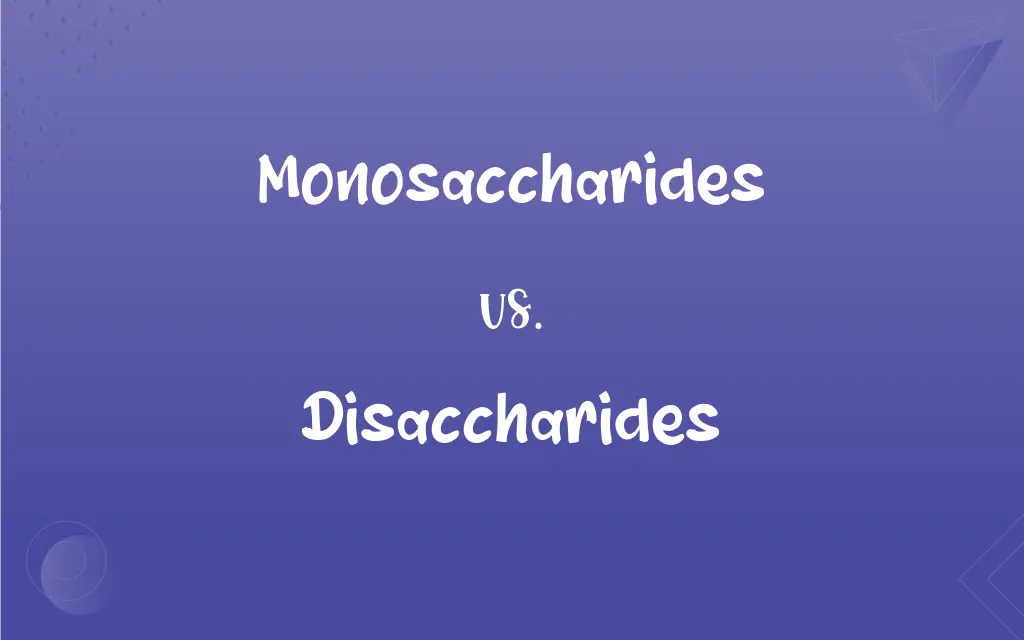Monosaccharides vs. Disaccharides: What's the Difference?
Edited by Aimie Carlson || By Harlon Moss || Updated on October 13, 2023
Monosaccharides are simplest carbohydrates, consisting of a single sugar unit. Disaccharides are carbohydrates formed by two monosaccharides linked together.

Key Differences
Monosaccharides serve as fundamental units, the simplest form of carbohydrates that cannot be hydrolyzed into smaller sugars. Disaccharides, on the other hand, can be broken down into two monosaccharide molecules, revealing their dimeric nature.
Monosaccharides, such as glucose and fructose, are integral to cellular respiration and energy production within organisms. Disaccharides, like sucrose, are crucial too, providing a source of energy upon being broken down into their monosaccharide components.
Monosaccharides exhibit varied functional groups, like aldehydes or ketones, and often participate in forming larger carbohydrates. Disaccharides demonstrate their role in dietary functions, being prevalent in various foods and serving as carbohydrate sources.
Monosaccharides possess isomeric forms, enabling them to appear structurally different while maintaining their single sugar unit identity. Disaccharides, through glycosidic linkages between monosaccharide units, present a structural aspect involving linkage location and orientation.
Monosaccharides hold significance in constructing complex carbohydrates and polysaccharides, forming the foundational units. Disaccharides, by combining varied monosaccharides, generate diversification in carbohydrate structures and functionalities.
ADVERTISEMENT
Comparison Chart
Basic Definition
Simple sugars with one sugar unit
Composed of two monosaccharide units
Hydrolyzable
Cannot be hydrolyzed further
Can be hydrolyzed into monosaccharides
Examples
Glucose, Fructose
Sucrose, Lactose
Complexity
Simple and cannot be broken down further
More complex and can be broken down
Glycosidic Linkages
Not applicable
Contains glycosidic linkage between sugars
ADVERTISEMENT
Monosaccharides and Disaccharides Definitions
Monosaccharides
Compounds with a single sugar unit, integral to metabolism.
Monosaccharides play a foundational role in cellular respiration.
Disaccharides
A pair of monosaccharide sugars connected via a glycosidic linkage.
Maltose, a disaccharide, is formed by linking two glucose molecules.
Monosaccharides
Basic units of carbohydrates, unable to be simplified further.
Glucose and fructose are common monosaccharides in our diet.
Disaccharides
Dietary sugars, offering energy post-hydrolysis into monosaccharides.
Disaccharides like lactose provide energy upon breakdown during digestion.
Monosaccharides
Singular sugar molecules, serving as building blocks for larger carbohydrates.
Monosaccharides like glucose contribute to energy production in cells.
Disaccharides
Carbohydrate structures that can be enzymatically split into simpler sugars.
Enzymes hydrolyze disaccharides into monosaccharides during metabolic processes.
Monosaccharides
Simple sugars that contribute to the formation of polysaccharides.
Starch, a polysaccharide, is composed of numerous monosaccharide units.
Disaccharides
Sugars constituted by two linked monosaccharide units.
Sucrose, a disaccharide, comprises glucose and fructose.
Monosaccharides
Singular sugar entities, offering energy and participating in carbohydrate synthesis.
Monosaccharides are essential in synthesizing more complex carbohydrates.
Disaccharides
Carbohydrate compounds, hydrolyzable into two simpler sugars.
When consuming disaccharides, enzymes split them into assimilable monosaccharides.
Monosaccharides
Any of several carbohydrates, such as tetroses, pentoses, and hexoses, that cannot be broken down to simpler sugars by hydrolysis. Also called simple sugar.
Disaccharides
Plural of disaccharide
Monosaccharides
Plural of monosaccharide
FAQs
Which enzymes are involved in breaking down disaccharides?
Enzymes like lactase, maltase, and sucrase break down disaccharides into monosaccharide units during digestion.
What is an example of a common dietary source of monosaccharides?
Honey is a rich source of monosaccharides, especially glucose and fructose.
How do plants store monosaccharides?
Plants store monosaccharides in the form of the polysaccharide starch.
What is the simplest form of carbohydrates?
Monosaccharides represent the simplest form of carbohydrates, consisting of a single sugar unit.
How are disaccharides formed?
Disaccharides are formed by linking two monosaccharides through a glycosidic bond during a dehydration reaction.
Why do disaccharides need to be broken down into monosaccharides?
Disaccharides need to be broken into monosaccharides because only monosaccharide units can be absorbed by the small intestine.
Which disaccharide is commonly found in milk?
Lactose, consisting of glucose and galactose, is the disaccharide commonly found in milk.
What is the caloric content comparison between monosaccharides and disaccharides?
Monosaccharides and disaccharides typically provide 4 kcal/gram, though the specific metabolic impact may vary.
How does the body transport monosaccharides?
Monosaccharides like glucose are transported via the bloodstream to various cells for utilization and storage.
Can individuals be intolerant to disaccharides?
Yes, lactose intolerance is a common condition where individuals cannot properly digest lactose, a disaccharide.
Are monosaccharides and disaccharides both soluble in water?
Yes, both monosaccharides and disaccharides are generally soluble in water due to their hydrophilic hydroxyl groups.
Can monosaccharides be directly used by the body for energy?
Yes, monosaccharides like glucose are directly usable by the body, often referred to as blood sugar, for energy.
What is the chemical formula for most monosaccharides?
Most monosaccharides, like glucose and fructose, have the chemical formula.
Are all monosaccharides sweet-tasting?
While many monosaccharides are sweet-tasting, like glucose and fructose, the level of sweetness can vary among them.
Is maltose a reducing sugar, and how does it relate to its monosaccharide units?
Maltose is a reducing sugar as it contains a free anomeric carbon, and it is composed of two glucose monosaccharide units.
Can disaccharides be found naturally in our diet?
Yes, disaccharides like lactose and sucrose are naturally found in foods such as milk and cane sugar, respectively.
Are disaccharides considered a type of carbohydrate?
Yes, disaccharides are a type of carbohydrate and contribute to dietary carbohydrate intake.
How are monosaccharides identified in a laboratory setting?
Monosaccharides can be identified using various chemical tests, such as Benedict’s test for reducing sugars.
What are the monosaccharide units of sucrose?
Sucrose, a disaccharide, is composed of one glucose unit and one fructose unit.
What role do monosaccharides play in DNA and RNA structure?
Monosaccharides form the sugar-phosphate backbone in DNA and RNA; deoxyribose in DNA and ribose in RNA.
About Author
Written by
Harlon MossHarlon is a seasoned quality moderator and accomplished content writer for Difference Wiki. An alumnus of the prestigious University of California, he earned his degree in Computer Science. Leveraging his academic background, Harlon brings a meticulous and informed perspective to his work, ensuring content accuracy and excellence.
Edited by
Aimie CarlsonAimie Carlson, holding a master's degree in English literature, is a fervent English language enthusiast. She lends her writing talents to Difference Wiki, a prominent website that specializes in comparisons, offering readers insightful analyses that both captivate and inform.
































































